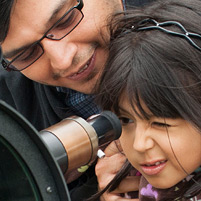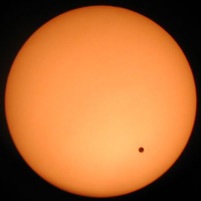Stargazing


Transit of Venus
Every summer during family vacations in the Adirondack Mountains, Ashley Disbrow (MCS'14) and her father would go out to the dock by the lake and stargaze.
Pointing out the constellations and planets, he sparked her lifelong love for astronomy.
"Our favorite was always Mars. It captured my imagination and got me interested in learning more about the universe," said Disbrow, who is now a physics major at Carnegie Mellon University.
Once she started attending public observation nights in the park, she was hooked.
"The most remarkable observation night we experienced was the first time I saw Saturn through a telescope," she said.
It's exactly this kind of enthusiasm CMU astronomers hoped they inspired when they invited the community to join them to view one of the rarest predictable astronomical events - the transit of Venus across the face of the Sun.
The transit of Venus is like a solar eclipse by the moon except that Venus, despite having a diameter more than three times that of the moon, is much farther away from Earth so Venus appears much smaller. The next transit of Venus won't happen again until December 11, 2117.
"I was encouraged by the large number of people, young and old, that turned out and their enthusiasm for astronomy," said Nick Battaglia, a McWilliams postdoctoral fellow in CMU's Department of Physics. "The event demonstrated what a great opportunity we have here at CMU to engage, educate and interact with Pittsburghers on astronomy-related topics."
Diane Turnshek, a CMU outreach coordinator; Michelle Ntampaka, special lecturer and lab technician; and Battaglia organized the event, complete with telescopes and special Sun-viewing glasses available for every stargazer.
During the course of the evening, more than 250 people gathered on the lawn between Doherty and Baker Halls. Overcast skies, however, sent most indoors to the university's brand new computer teaching cluster in Wean Hall where they could watch NASA's live feed of the transit from Hawaii on six large screens.
Fourteen volunteers — ranging from professors, researchers and visiting scholars to post docs, grad students, staff and undergraduates — mingled through the crowd to explain the event's significance and answer questions.
Venus transits are of historical importance as astronomers used them to determine the distance between Earth and the Sun for the first time. Venus transits also gave astronomers their first realistic estimates of the size of our solar system.
Turnshek explained, "In the 1700s, teams from different spots on the Earth recorded the start and end times of transit, which varied from one team to the next."
She continued, "The teams knew precisely how many kilometers they were apart and used simple geometry — knowing two angles and the side in between them — to find the distance to the Sun to within one percent of the actual value."
Venus takes six hours to cross the face of the Sun, but even if the skies had been clear, stargazers would have only seen a couple of hours of that before the Sun set for the evening, Turnshek said.
"People were just thrilled to talk about it, even though it was cloudy," said Turnshek, who exchanged contact info with many of the people. Outreach coordinators like Turnshek extend the bounds of the university to the community by finding interested clubs, Scout troops, church groups, alumni, science fair organizers and especially school teachers to host university scientists.
"Many were teachers, and so we're already planning to have our physicists here at CMU go into their classrooms next year and talk to their students about science."
Related Links: Outreach: Dept of Physics | Bruce and Astrid McWilliams Center for Cosmology | Shedding Light | Mellon College of Science
